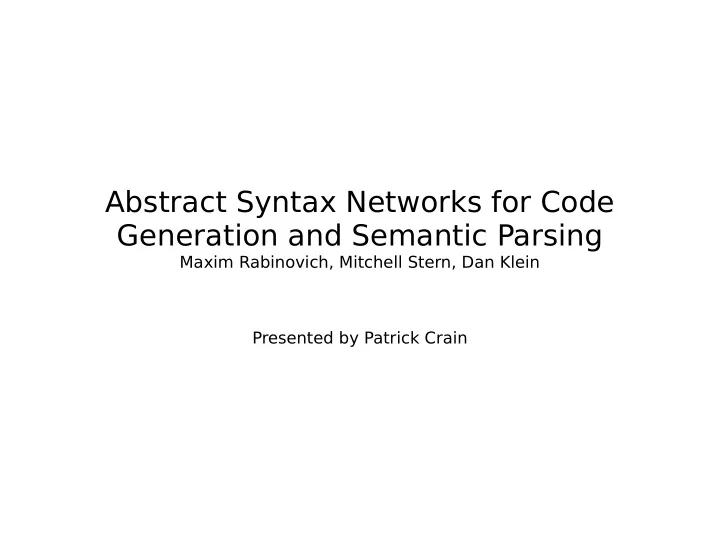

Abstract Syntax Networks for Code Generation and Semantic Parsing Maxim Rabinovich, Mitchell Stern, Dan Klein Presented by Patrick Crain
Background ● The Problem – Semantic parsing is structured, but asynchronous – Output must be well-formed → diverges from input ● Prior Solutions – S2S models [Dong & Lapata, 2016; Ling et al., 2016] – Encoder-decoder framework – Models don't consider output structure constraints ● e.g., well-formedness, well-typedness, executability
Semantic Parsing Show me the fare from ci0 to ci1 lambda $0 e ( exists $1 ( and ( from $1 ci0 ) ( to $1 ci1 ) ( = ( fare $1 ) $0 ) ) )
Code Generation
Abstract Syntax Networks ● Extends encoder-decoder framework ● Use AST s to enforce output well-formedness ● Decoder is modular; submodels natively generate AST s in a top-down manner ● Structure of AST s mirrors input’s call graph ● Decoder input has both a fxed encoding and an attention-based representation
Related Work ● Encoder-decoder architectures – Machine translation (sequence prediction) – Constituency parsing (tree prediction) ● Flattened output tree [Vinyals et al., 2015] ● Construction decisions [Cross & Huang, 2016; Dyer et al., 2016] – ASNs created with recursive top-down generation → keeps tree structure of output
Related Work (cont.) ● Neural modeling of code [Allamanis et al., 2015; Maddison & T arlow, 2014] – Neural language model + CST s – Used for snippet retrieval ● Grammar-based variational autoencoder for top-down generation [Shin et. al., 2017] ● Program induction from IO pairs [Balog et al., 2016; Liang et al., 2010; Menon et al., 2013]
Structure of AST s ● Code fragments → trees with typed nodes ● Primitive types (integers, identifers) – T yped nodes with a value of that type (atomic) ● Composite types (expressions, statements) – T yped nodes with one of the type's constructors – Constructors specify the language constructs nodes represent, including children and their cardinalities ● ASTs can represent semantic parsing grammars
Input Representation ● Collections of named components, each consisting of a sequence of tokens ● Semantic parsing: single component containing the query sentence ● HEARTHSTONE: name and description are sequences of characters & tokens; attributes are single-token sequences
Model Details ● Decoder: collection of mutually recursive modules – Structure of modules mirrors AST being generated – Vertical LSTM stores info throughout decoding process – More on modules shortly ● Encoder: bi-LSTMs for embedding components – Final forward / backward encodings are concatenated – Linear projection is applied to encode entire input for decoder initialization
Attention ● Attention solves the need to encode arbitrary- length data with fxed-length vectors ● Idea: keep the encoder's intermediate outputs so we can relate input items to output items – Compute each input token’s raw attention score using its encoding & the decoder's current state: – Compute a separate attention score for each input component:
Attention (cont.) ● Sum raw token- and component-level scores to get fnal token-level scores: ● Obtain attention vector using a softmax over the token-level attention scores: ● Multiply each token's encoding by its attention vector and sum the results to get an attention-based context vector: ● Supervised attention: concentrate attention on a subset of tokens for each node
Primitive T ype Module ● Each type has a module for selecting an appropriate value from the type's domain ● Values generated from a closed list by applying softmax to vertical LSTM's state: ● String types may be generated using either a closed list or a char-level LSTM
Composite T ype Module ● Each composite type has a module for selecting among its constructors ● Constructors are selected using the vertical LSTM’s state as input & applying a softmax to a feedforward net’s output:
Constructor Module ● Each constructor has a module for computing an intermediate LSTM state for each of its felds ● Concatenate an embedding of each feld with an attention vector and use a feedforward net to obtain a context-dependent feld embedding: ● Compute an intermediate state in the vertical LSTM for the current feld:
Constructor Field Module ● Each constructor feld has a module to determine the number of children associated with it, and to propagate the state of the vertical LSTM to them ● Singular : forward LSTM state unchanged: ● Optional : use a feedforward network on the vertical LSTM state → apply a sigmoid function to determine the probability of generating a child:
Constructor Field Module (cont.) ● Sequential : use a decision LSTM to iteratively decide whether to generate a new child; after a "yes", update a state LSTM with the new context-dependent embedding Decision Vertical Update Context Update Horizontal Update
Evaluation ● Semantic Parsing: – Uses query → logical representation pairs – Lowercase, stemmed, abstract entity identifers – Accuracies computed with tree exact match ● Code Generation (HEARTHSTONE): – Uses card text → code implementation pairs – Accuracies computed with exact match & BLEU
Results – Semantic Parsing ● JOBS: SotA accuracy, even without supervision ● ATIS and GEO: Falls short of SotA, but exceeds / matches [Dong & Lapata, 2016] – ASNs don’t use typing information or rich lexicons
Results – Code Generation ● HEARTHSTONE: Signifcant improvement over initial results – Near perfect on simple cards; idiosyncratic errors on nested calls – Variable naming / control fow prediction are more challenging ● Current metrics approximate functional equivalence – Future metrics that canonicalize the code may be more efective ● Enforcement of semantic coherence is an open challenge
Conclusion ● ASNs are very efective for ML tasks that transform partially unstructured input into well-structured output ● Recursive decomposition in particular helps by ensuring the decoding process mirrors the structure of the output ● ASNs attained SotA accuracies on JOBS / HEARTHSONE; supervised attention vectors led to further improvements ● ASNs could not match SotA accuracies on ATIS or GEO due to lack of sufcient typing information or lexicons ● Overcoming more challenging tasks, evaluation issues, and modeling issues remain open problems
Recommend
More recommend